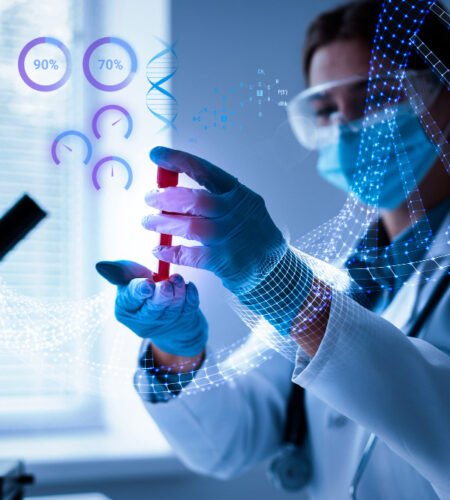When humans begin combining biology with technology is what is biotechnology, a world of endless possibilities unfolds before us. It is the power to recode life itself, to reshape our existence in ways we could never have imagined. With the advent of biotechnology, we are entering a new phase in humanity’s evolution, where we transform from mere observers of nature to its masters.
In this brave new world, we witness the emergence of organ farms, where governments utilize artificial wombs to rebuild populations and robots with biological parts. Genetically altered humans possess the ability to heal others through touch and a myriad of other extraordinary abilities. But amidst these marvels, questions arise about the impact on our environment and what lies hidden in the underground labs of biohackers, away from regulations and oversight.

What is Biotechnology
Bioprinting, a revolutionary technique, allows us to create three-dimensional or even four-dimensional structures using living cells known as bioinks. These cells are printed layer by layer, growing and connecting with each other to form intricate biological structures. Bioprinting is not just about creating objects; it is about breathing life into them, fulfilling the alchemist’s dream.
The applications of bioprinting are vast and diverse. From bioprinted eyeball corneas to combat hair loss, from personal cosmetic testing to healing combat wounds, the possibilities seem endless. Looking further into the future, advanced bioprinting may enable us to create 3D printed coral reefs that restore damaged ecosystems or microgravity bioprinting factories in space stations.
When it comes to the human body, bioprinted organs offer a solution to the challenges posed by organ shortages. Organ farms manufacture these organs, utilizing a patient’s own cells to create miniaturized organs or organoids for medical testing before actual administration. Bioprinted prosthetic limbs designed with living tissue improve integration with the host’s body, offering a seamless experience.
The field of cybernetics embraces the fusion of electronics and bioprinted pieces, resulting in cybernetic organs that surpass natural ones in terms of advancement. Imagine bioprinted lungs implanted with sensors and nano filters that remove toxins from the air before they enter the bloodstream or bionic eyeballs with built-in zoom or infrared vision. Individuals equipped with experimental bionic eyeballs claim to experience paranormal visions, leading them on a quest to uncover hidden secrets.
In another part of the world, scientists combat a flesh-eating disease using bioprinting to create a new type of skin that can withstand the onslaught. While some commend these efforts, others raise concerns about whether these individuals with modified skin are still considered part of the human race.

Beyond human enhancements, biotechnology jobs also revolutionizes architecture. Living buildings constructed with bioengineered materials possess self-repairing capabilities, air-cleaning properties, and the ability to reproduce. Inspired by geckos and coral reefs, these buildings utilize gecko-inspired adhesives and eco-concrete. Some even harness biological batteries powered by bacteria.
Living near the ocean, city bio apartments are protected from rising sea levels by genetically engineered corals and muscles forming living seawalls. The integration of bioluminescent lights replaces conventional streetlights, illuminating cities while reducing energy consumption.
While these advancements bring great benefits, there are also instances of misuse and manipulation. Companies intentionally render their biomaterials obsolete, forcing customers into a cycle of continuous replacement. Artists dabble in bioart, using living tissue and bioprinters to create living and evolving works.
Underground biohackers venture beyond the boundaries of regulations, implanting microchips into their bodies and tattooing themselves with digital inks. They build biocomputers from biomaterials and living neural tissue, pushing the limits of neural experiences by disabling safety features. Cryonic punks freeze each other, hoping to bring life back from death’s grip. Pets with edited genes emit bioluminescence, glowing in the dark.
Rumors circulate about chimeras—animals created with genes from multiple species—drawing inspiration from Greek mythology’s fire-breathing creature. In the real world, corporations drive obsolescence in older bionic prosthetics, challenging the ownership rights of limbs between individuals and corporations.
Artificial womb technology emerges as a beacon of hope in a world grappling with infertility. Artificial wombs in government-controlled labs offer reliable external pregnancy and gestation options known as ectogenesis. Wealthy individuals outsource childbirth to large womb farms while conspiracies abound about dictators using artificial wombs to perpetuate their rule eternally.
Extended gestation experiments leave bodies in artificial wombs for extended periods, enhancing cognitive and physical capabilities naturally. The multi-trillion-dollar industry of biohybrid robots combines biological tissue with robotics, offering flexible and energy-efficient machines. Some biomimetic robots blend seamlessly into nature, raising concerns about unintentional disruption to ecosystems and potential espionage capabilities.
In the aftermath of a nuclear-scale biowaste catastrophe, immune biohybrid robots become humanity’s saviors—scavenging resources, rescuing survivors, and cleaning up biohazard waste. These robots even restore extinct animals, carrying their DNA and birthing lost species.
Amidst this transformation, a new breed emerges—neo-humans or real-life X-Men. Mostly comprised of biohackers who have surpassed traditional notions of humanity, they represent an entirely new species. From becoming human insect repellents through engineered pheromones to turning vocal cords into living musical instruments, they push the boundaries of what it means to be human.
As advancements continue at an unprecedented pace, ethical dilemmas arise. Who owns bionic limbs—the individuals or the corporations? Tracking numbers accompany every prosthetic and bio-exoskeleton in a world filled with registration and control.
Meanwhile, governments test advanced artificial womb technology behind closed doors while experiments in extended gestation hold promises of enhanced cognitive abilities. The age of BIO hybrid robots dawns upon us—a world where biological tissue fuses seamlessly with machines for environmental monitoring or scientific research. Yet fears persist about unintended consequences such as invasive species disrupting ecosystems or espionage efforts disguised as animals.


Comments